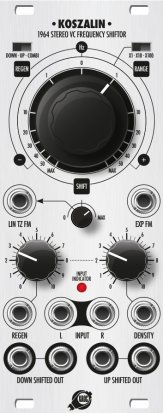The AC company was able to send someone yesterday at around noon. Apparently they usually have 2 people on duty on weekends, but they had 15 volunteers to work overtime. And yes, it was the run capacitor, it was still under warranty, and replacing it was a very quick job.
Overall the hallway thermostat got as high as 87; it never got below 82 even when it rained and cooled to the mid-60s overnight. Of course the temperature in that particular spot only very loosely correlates to the temperature in the places where we actually spend our time.
The other thing I have cooled off on is the Xaoc Sofia. For most of Superbooth there was no video coverage of Xaoc’s new stuff online, no matter how often I refreshed my searches. 🙂 But this morning two videos appeared, and… eh, I can do without the module really.

But what I’m looking at now is one of Xaoc’s other new things, the Koszalin frequency shifter. I wrote it off originally because a freq shifter — which inharmonically lowers and/or raises the frequency of the incoming signal by some constant Hertz value, as opposed to a pitch shifter which changes incoming frequencies proportionally and keeps them all in tune — struck me as kind of a niche effect. At low ranges, it’s a swirly sound reminiscent of a psychedelic 70s flanger. At higher ranges it sort of sounds like an extra harsh ring modulator.
But as the demos pointed out, one thing you can do with a stereo frequency shifter is to shift up, process the signal with some other effect, and shift back down — causing the effect to act a little differently but staying in tune. That idea inspired me to give the frequency shifters in Bitwig and VCV Rack a try this morning. Okay, cool… but then I want back to watch the original Koszalin announcement video, and that thing really sounds freaking great. The Density control which affects feedback (I think by filling in delayed copies relative to the shift frequency) adds a lot, and it’s also got TZFM which is unique in a frequency shifter. The feedback sits just below self-oscillation, so it can be pinged like a filter, and in some ways it kind of sits the resonator space. So, that’s a strong contender.
To my ears, the other winner of Superbooth is Klavis Grainity — a “granular VCF” which immediately made everyone ask “what is a granular VCF?” It’s an analog multimode filter that has 13 different simultaneous modes, which are sliced and combined under digital control. Something very much like a wavetable oscillator sets the pattern of those slices, and that oscillator automatically tracks the pitch of the input signal, but can be detuned and divided. The upshot is, it adds all kinds of texture and waveshaping and phase modulation along with its filtering, and it sounds pretty amazing. Plus you can just use one of 6 of the filter modes without the fancy granular aspect and mix that in or use it separately.
These would be a total of probably 20-22 HP (the width of Grainity wasn’t announced). I’m still thinking it’d be Manis Iteritas and Ensemble Oscillator that would make way for these — so as of now, they’re both sort of on trial to decide whether or not I can part with one or both.
